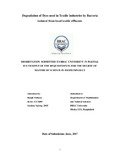Degradation of dyes used in textile Industries by bacteria isolated from local textile effluents

View/
Date
2017-06Publisher
BRAC UniversityAuthor
Sultana, BanjirMetadata
Show full item recordAbstract
The effluent discharges from textile processing industries contain a significant amount of unreacted dyes. Release of these dyes into the environment causes toxic effects to the environment. The application of microorganisms for biodegradation of dyes is an attractive method for the wastewater treatments. In present study 10 different bacteria isolated from textile effluent were tested for decolorization ability of some common dyes like Novacron Ruby, Novacron Navy, Novacron Yellow Novacron, Novacron Blue dk and Novacron super black dyes. Based on morphological and biochemical characteristics, the isolates were provisionally identified as Micrococcus sp, Bacillus sp, Pseudomonas sp and Enterococcus sp. Out of 10 isolates 3 bacterial isolate found to posses significant decolorization ability and their identification was confirmed by Biolog identification system as Bacillus badius, Bacillus thurengiensis and Enterococcus faecium. The optimum condition for decolorization was observed at pH 7, temperature 37˚C, with 10% inocula size and 100mg/l dye concentration under stationary condition. All the 3 isolates showed maximum decolorization after 72 hrs of incubation. Beef extract and sucrose served as best nitrogen and carbon source respectively for the growth of these organisms. Under optimized condition percent decolorization by Bacillus thurengiensis of all Novacron dyes was 91.2-98.3%, Bacillus badius 89.2-96.4% and Enterococcus faecium 85.1-91.3%.Biodegradation of dyes was confirmed through UV-VIS Spectrophotometer. An experiment on growth of agriculturally important bacteria revealed non toxic nature of decolorized products (100 mg /L) as compared to original dye. Gel electrophoresis study showed the presence of low mol wt protein in the bacterium growing under dye stress condition supporting the mechanism of biodegradation.
